History
Nicastro's origins trace back to the 9th century, when Calabria was part of the Byzantine Empire, when a fortress called Neo Castrum ("New Castle") was created. The centre was founded during the time of Saracen raids (IX-Xcentury), pushing coastal inhabitants to move to surrounding higher fortified ground.
However, many finds dating back to the Neolithic age and from the Magna Graecia era (IV century BC) have emerged.
In 1057, the area was conquered by the Normans, but Nicastro revolted against Robert Guiscard and his brother Roger. Having dominated the revolt, the new nobiliary had the Castle built, which was restored in the XIII century by Frederick II of Swabia in the XIII century. The castle of Nicastro served as the place of imprisonment of Frederick II's son Henry.
Giovanni Antonio Facchinetti, who was briefly Innocent IX, was the bishop of Nicastro from 1560 to 1572.
The area suffered greatly in the earthquakes of 1638, which destroyed the cathedral and the Benedictine abbey of St. Euphemia, founded by Robert Guiscard. Valuable archives were lost in the ruins.
Until the 18th century, in Nicastro and its surroundings sericulture was a very widespread and prosperous activity, so much so that five thousand pounds of raw silk were produced every year. [1] According to the historian Giuseppe Maria Galanti, at the end of the 18th century, sericulture alongside the cultivation of mulberry trees for the breeding of silkworms were still practiced, however there was a decline in the production. [2]
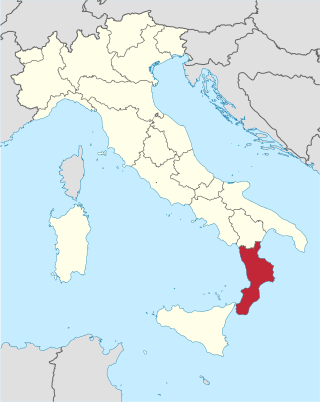
Calabria is a region in southern Italy. It is a peninsula bordered by Basilicata to the north, the Ionian Sea to the east, the Strait of Messina to the southwest, which separates it from Sicily, and the Tyrrhenian Sea to the west. It has almost 2 million residents across a total area of 15,222 km2 (5,877 sq mi). Catanzaro is the region's capital.

Robert "Guiscard" de Hauteville, sometimes Robert "the Guiscard", was a Norman adventurer remembered for his conquest of southern Italy and Sicily in the 11th century.
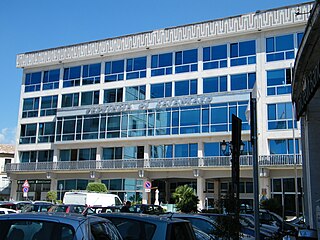
The province of Catanzaro is a province of the Calabria region of Italy. The city Catanzaro is both capital of the province and capital of the region of Calabria. The province contains 80 comuni. Its provincial president is Sergio Abramo.
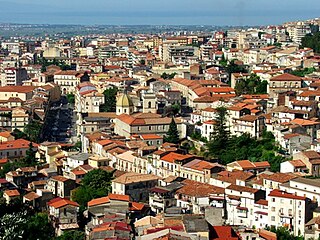
Lamezia Terme, commonly called Lamezia, is an Italian city and comune of 70,452 inhabitants (2013), in the province of Catanzaro in the Calabria region.

Maida is an italian town and comune in the province of Catanzaro, in the Calabria region of southern Italy. The British routed the French in the Battle of Maida in 1806, as part of the War of the Third Coalition.
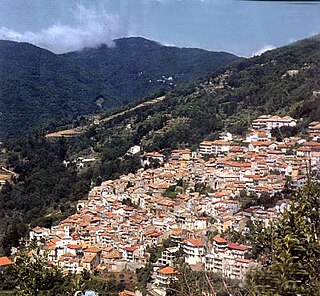
San Pietro Apostolo is a comune and town in the province of Catanzaro in the Calabria region of Italy. It is about 15.3 kilometres (9.5 mi) northwest of Catanzaro, the provincial capital.

Paola is an Italian comune of 15,408 inhabitants in the province of Cosenza in Calabria.

The Norman conquest of southern Italy lasted from 999 to 1194, involving many battles and independent conquerors.
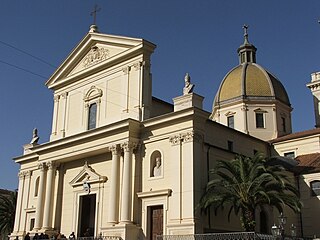
The Diocese of Lamezia Terme is a Latin Church diocese of the Catholic Church in Calabria. In 1818 the ancient see of Martirano, the former Mamertum, was united to the diocese of Nicastro. The diocese was then a suffragan of the archdiocese of Reggio in Calabria. In 1986, the historic Diocese of Nicastro had its name changed. It is currently called the Diocese of Lamezia Terme, and it is a suffragan of the Archdiocese of Catanzaro-Squillace. The name change reflects the incorporation of the comune of Nicastro into Lamezia Terme, an administrative change of 1968 on the part of the State of Italy.

Castagna is a small village in Carlopoli of the province of Catanzaro, Region of Calabria, Italy. In the English language, castagna is chestnut. Many Castagnese emigrated in the late 19th and early 20th century. Most inhabitants ended up in Utica, New York and some in Ontario. It is also home to the Abbey of Santa Maria di Corazzo.
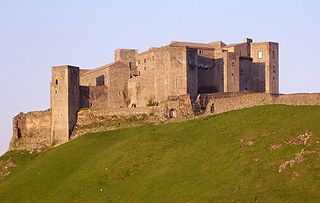
The Castle of Melfi in Basilicata is a monument owned by the Italian State and one of the most important medieval castles in Southern Italy. Its construction, at least the components still visible, dates back to the Norman conquest and has undergone significant changes over time, especially under the House of Anjou and the Crown of Aragon.

Lamezia Terme Centrale railway station is the main railway station serving the city and comune of Lamezia Terme, in the Calabria region, Southern Italy. Opened in 1894, it forms part of the Battipaglia–Reggio di Calabria railway, and is also a terminus of a secondary line, the Lamezia Terme–Catanzaro Lido railway.

Terina was an ancient city located on the Piano di Tirena hill in Sant'Eufemia Vetere about 20 km (12 mi) from Lamezia Terme in Calabria. The site of the city was allegedly found in 1922 by the archaeologist Paolo Orsi near the modern village of Sant'Eufemia Vetere. A systematic archaeological investigation was made from 1997 and coins, inscriptions and other artefacts retrieved from the site can be seen in the Museo Archeologico Lametino in Lamezia Terme.
The Lamezia Terme Town Library is located in the historic centre of the former village of Nicastro, in the province of Catanzaro in the Calabria region of Italy. It is situated in the Nicotera-Severisio historical building located in the Tommaso Campanella square.

Nicastro Cathedral is a Roman Catholic cathedral dedicated to Saints Peter and Paul in the town of Nicastro, now part of the city of Lamezia Terme, in the province of Catanzaro, in the Calabria region of southern Italy. It was previously the episcopal seat of the Diocese of Nicastro and when the diocese changed its name to the Diocese of Lamezia Terme, remained its cathedral.
Marco Antonio Mandosio or Marco Antonio Mondosio (1606–1638) was a Roman Catholic prelate who served as Bishop of Nicastro (1637–1638).

The strada statale 18 "Tirrena Inferiore" is an Italian state road, connecting Campania and Calabria. It is among the longest and most important state highways in southern Italy, considering that it follows the Tyrrhenian coast, from Salerno to Reggio di Calabria.
Pietro Francesco Montorio (1556–1643) was a Roman Catholic prelate who served as Apostolic Nuncio to Germany (1621–1624) and Bishop of Nicastro (1594–1620).

The Gulf of Saint Euphemia is a gulf on the west coast of Calabria, southern Italy. It is part of the Tyrrhenian Sea and borders the province of Cosenza, the province of Catanzaro, and the province of Vibo Valentia.
A series of mainshocks struck Calabria on March 27–28 and June 9, 1638. The first three earthquakes had moment magnitudes estimated to be 6.6–7.1. On June 9, another mainshock estimated at Mw 6.7 struck the same region, causing further damage and casualties. The four earthquakes resulted in as many as 30,000 fatalities.















